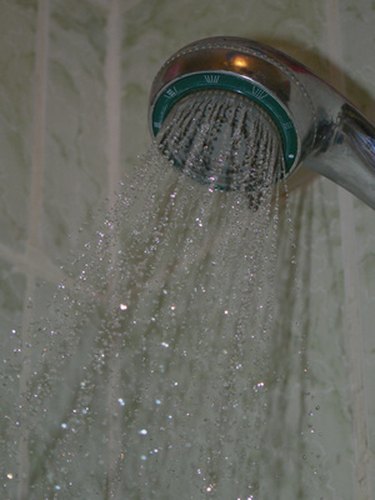Things You'll Need
Pencil
Power drill
1/2-inch wood drill bit
Tape measure
Felt tip pen
Hacksaw
Tradesman's knife
ABS couplings
ABS shower sewer pipe
ABS P-trap
Strapping
Plumber's putty
Shower drain adaptor
Adjustable wrench

Every household has a main sewer line that individual water fixture sewer pipes run into. These pipes are attached to the main sewer line via connecting couplings. The shower sewer line runs over to the shower base and into a P-trap, which stops sewer gasses from traveling up through the shower base drain. The P-trap connects to the shower base drain adaptor by a length of sewer pipe that is glued to the P-trap. The shower drain base is first moved to its new location, and a hole is drilled through the floor for the sewer line to meet the drain adaptor.
Step 1
Move the base to the new location. Place a pencil through the hole in the base and mark the floor so that it equals the size of the shower base's perimeter hole. Remove the base. Drill around the hole mark, using a 1/2-inch wood drill bit.
Video of the Day
Step 2
Mark the existing shower sewer line 12 inches from where it connects into the house's main sewer line. Use a hacksaw to cut through the pipe at the mark. Make the cut straight. Remove burrs with a tradesman's knife. Apply ABS glue to the end of the cut pipe, and one inside end of an ABS coupling (depending on the location of the new shower, this coupling may be a straight or angled coupling). Push the coupling onto the end of the cut pipe and hold for 30 seconds.
Step 3
Glue the other end of the coupling, and one end of a new piece of shower sewer pipe. Push the pipe into the coupling and hold for 30 seconds. Install the new pipe and couplings so it reaches to below the shower base.
Step 4
Glue a P-trap to the end of the sewer pipe. Make sure the vertical part of the P-trap is directly below the shower base hole. Cut a new piece of sewer pipe long enough to reach from the P-trap up to, and flush with, the shower base hole. Glue the piece of sewer pipe to the P-trap. Brace the sewer pipe to hold it in place.
Step 5
Apply plumber's putty to the underside lip of the shower drain adaptor, and push it through the shower base hole. Push the rubber washer onto the adaptor's thread on the bottom side of the shower base, then thread on the adaptor nut. Tighten it in place with an adjustable wrench.
Step 6
Place the shower base in position--the top of the sewer pipe will enter up through the hole in the center of the drain adaptor. Push the thick rubber washer down into the adaptor, between the sewer pipe and adaptor walls. Push it into place using a flat-headed screwdriver. Screw the adaptor ring down into the top of the adaptor. Use the oblong metal key to thread the adaptor ring down onto the rubber washer. This will expand the washer and create a water-tight seal between the pipe and adaptor. Take out the adaptor key, and push on the adaptor's circular cover plate.
Tip
If installing PVC sewer pipes, prime all joints first with PVC primer, and then apply PVC glue. All horizontal sewer pipes need to installed at a gradient to allow for waste to travel along the pipe. Check with local city codes regarding the correct gradient in your area.
Video of the Day